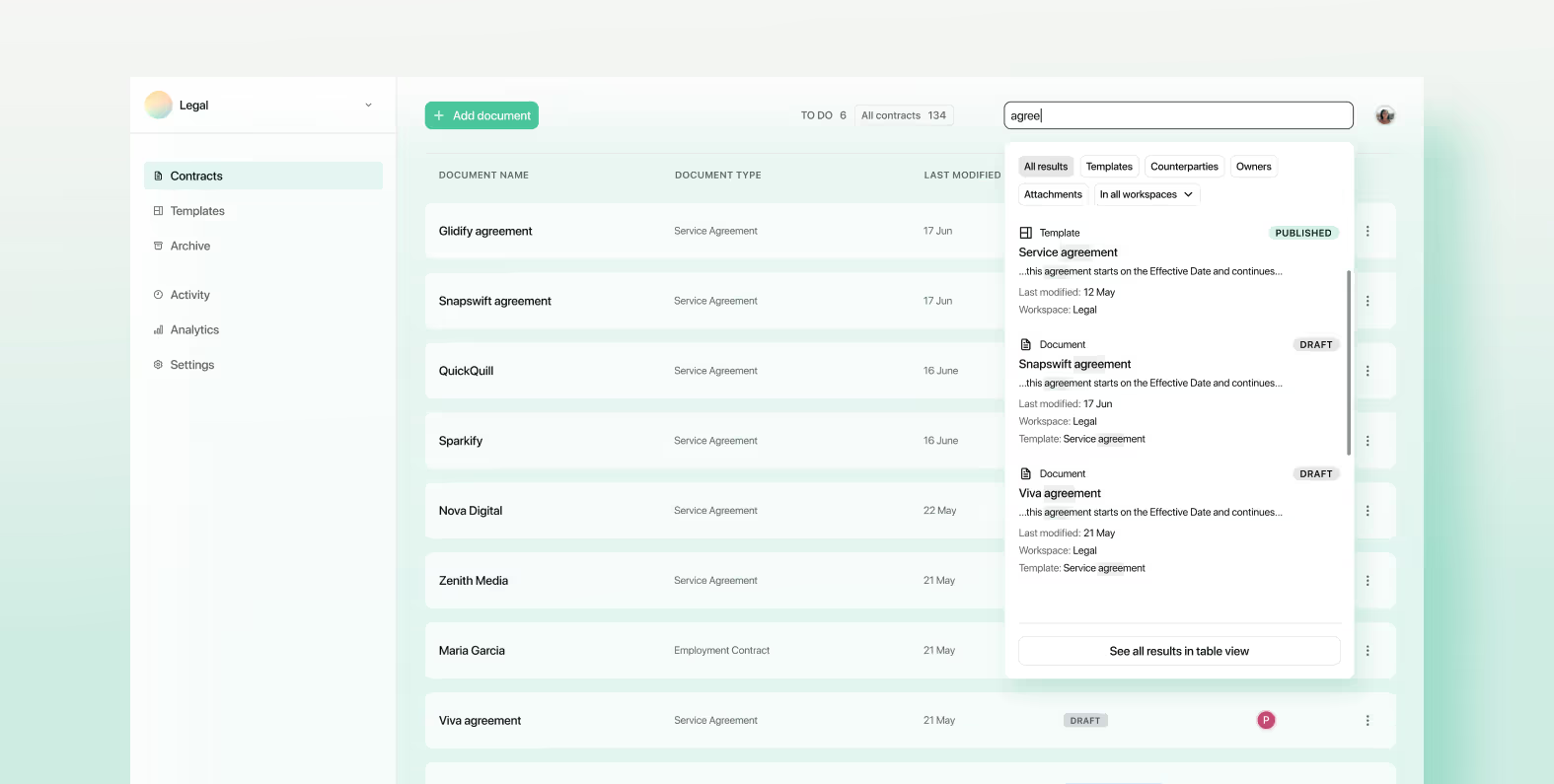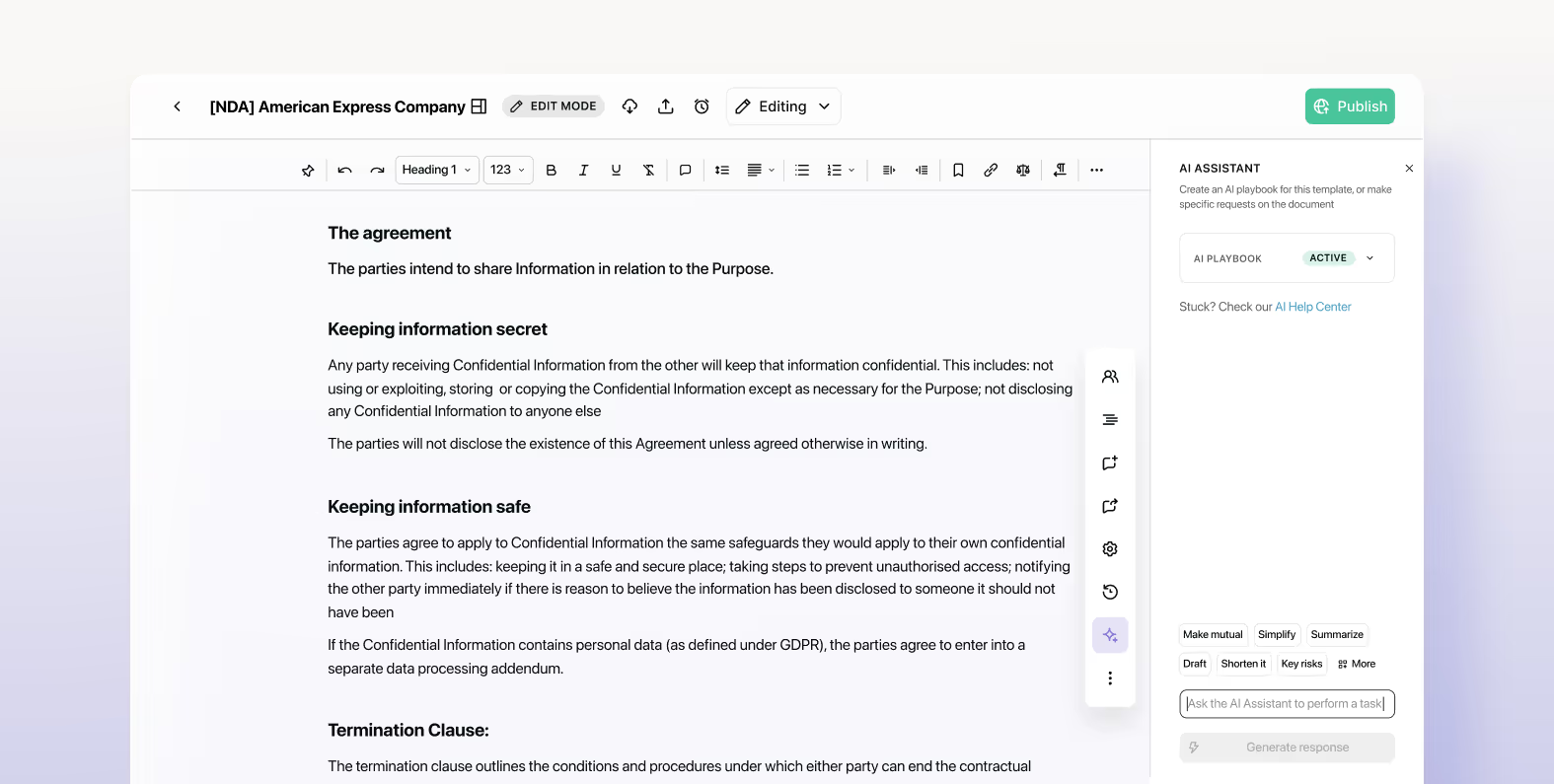Solutions
Customer Support
Resources
Download this business transfer agreement template to safely manage the sale or transfer of business assets and liabilities.




A business transfer agreement is a vital document for any company involved in the buying or selling of a business. It outlines the terms and conditions of the transfer, ensuring that both parties are clear on their obligations and rights.
This article explores what business transfer agreements are, their purpose and who manages them. It also looks at what a business transfer agreement template should include, the challenges of managing these templates and how you can automate the process with Juro.
A business transfer agreement is a legal document that formalizes the sale and transfer of a business from one party to another. This agreement covers the transfer of assets, liabilities, and operations.
Similar to a business sale agreement, a transfer agreement ensures that both parties agree on what is being transferred and under what conditions. This is crucial for providing legal protection and clarity – both for the buyer and the seller.
A business transfer agreement is a legal document that outlines the terms and conditions under which a business is transferred from one party to another. Its primary purposes include:
Business transfer agreements are typically managed by a combination of the following parties:
The successful management of a business transfer agreement requires collaboration among these various parties to address the legal, financial, operational and regulatory aspects of the transaction.

Business transfer agreements are utilized in various scenarios, each requiring specific terms and considerations. Here are some common use cases:
When an entrepreneur or a company decides to sell their business to another party, a business transfer agreement outlines the terms of the sale, including the purchase price, transferred assets and liabilities. This can involve the sale of small businesses, franchises, or large corporations.
During mergers or acquisitions, a business transfer agreement helps facilitate the transfer of one company’s assets and operations to another. This includes specifying the merger terms, handling employee transitions, and integrating business operations.
When a company's management team purchases the business from its current owners, a business transfer agreement is used to detail the terms of the transfer, ensuring that management smoothly assumes ownership and control.
In cases where only specific assets of a business are being transferred (rather than the entire business entity), a business transfer agreement outlines which assets are included – for example, equipment, intellectual property and inventory.
When a company decides to sell off a division or subsidiary, a business transfer agreement ensures that all relevant assets, liabilities and operations of that division are correctly transferred to the buyer.
For family-owned businesses or privately-held companies, a business transfer agreement is crucial in transferring ownership and management to the next generation or new leaders, ensuring continuity and preserving the business’s legacy.
When two or more businesses form a joint venture or partnership, a business transfer agreement can outline the terms of asset and resource contributions from each party, defining ownership stakes and operational responsibilities.
During bankruptcy proceedings or corporate restructuring, a business transfer agreement may be used to sell off parts of the business to satisfy creditors, allowing the remaining parts to continue operating under new ownership.
When a franchisee sells their franchise location to another franchisee, a business transfer agreement details the terms of the sale, including adherence to the franchisor’s requirements and continuity of operations.
A comprehensive business transfer agreement template should include the following key sections:
Title and introductory section. Title, date, names and addresses of parties, and recitals.
Definitions. Clear definitions of key terms used in the agreement.
Description of the transfer. Detailed description of the business, scope and any excluded assets or liabilities.
Purchase price and payment terms. Total purchase price, payment structure, adjustments, methods and timelines.
Representations and warranties. Seller's and buyer's representations and warranties regarding the business and transaction authority.
Covenants. Pre-closing and post-closing covenants, including non-compete and confidentiality agreements.
Conditions precedent. Conditions that must be satisfied before the transfer can be completed.
Closing and transfer procedures. Closing process details, actions at closing and post-closing obligations.
Employee matters. Treatment of existing employees, continuation of employment and transfer of benefits.
Indemnification. Provisions for indemnification for breaches of representations, warranties and covenants.
Dispute resolution. Mechanisms for resolving disputes and governing law.
Confidentiality.: Obligations to maintain confidentiality of sensitive information.
Miscellaneous provisions. Entire agreement clause, amendments, waivers, assignment, notices, severability and counterparts.
Signatures. Signature lines for authorized representatives and date of signatures.

The following structured steps help to ensure that all legal, financial and operational aspects are thoroughly addressed, leading to a successful and smooth transition of business ownership.
The management of a business transfer agreement begins with an initial assessment and planning phase. In this stage, both parties define the scope of the transfer, identifying key assets, liabilities and other components to be included in the transaction. Preliminary discussions between the buyer and seller help outline the basic terms and objectives of the transfer. This phase sets the foundation for a smooth transaction by clarifying the expectations and goals of both parties.
To ensure all aspects of the business transfer are properly handled, it is crucial to engage a team of professionals. This team typically includes legal counsel to draft and review the agreement, financial advisors to conduct valuations and financial assessments, tax advisors to understand the tax implications, and HR professionals to manage employee-related matters. Each professional brings specialized expertise to address different facets of the transfer, ensuring a comprehensive approach.
A thorough due diligence process is essential to evaluate the business’s financial health, legal standing, and operational capabilities. During this phase, the buyer reviews all relevant documents, including contracts, intellectual property, regulatory compliance records, and financial statements. Due diligence helps identify potential risks and liabilities, providing a clear picture of the business’s condition and informing the negotiation process.
With the insights gained from due diligence, legal counsel drafts the business transfer agreement. This document includes key sections such as the purchase price, payment terms, representations and warranties, covenants and indemnification clauses. Both parties then engage in negotiations to finalize the terms of the agreement. This phase involves addressing any issues or concerns raised during due diligence and ensuring that the agreement reflects the interests and protections for both sides.
Once the terms are finalized, the agreement must be approved by the necessary parties, which may include boards of directors, shareholders or regulatory authorities. After obtaining these approvals, the agreement is then executed with signatures from authorized representatives of both parties. This formalizes the commitment to the terms outlined in the agreement and paves the way for the transfer to proceed.
In the final stage, preparations are made for the closing of the transaction. This involves coordinating with all involved parties to ensure that all conditions precedent are met – such as obtaining third-party consents and transferring assets. After the closing, the focus shifts to post-closing obligations and transition activities, such as integrating operations, transferring employees and implementing any agreed-upon support measures to ensure a smooth transition.
Juro’s AI-native contract management platform is designed to streamline the management of business transfer agreements and subsequent contracts. Here’s how Juro can assist:


After the business transfer, various other contracts need to be managed effectively. Juro also provides tools to handle these contracts efficiently.
Employee onboarding and transfers – Juro streamlines the creation and management of employment contracts, and ensures that these comply with relevant labour laws and regulations. This ensures smooth onboarding or transfer of employees post-sale and reduces legal risk.
Vendor and supplier contracts – Juro helps maintain consistent terms across vendor and supplier contracts, ensuring favorable conditions and reducing discrepancies. Juro also allows you to track contract renewal dates and terms, and provides timely reminders to renegotiate or renew.
Customer contracts – Juro automates the generation and approval of customer contracts, so you can onboard quickly. You can also make updates or amendments quickly and easily, so that all agreements reflect the latest terms and conditions.
By leveraging Juro’s comprehensive contract management platform, businesses can ensure that all aspects of their business transfer agreements and subsequent contracts are managed efficiently, accurately and compliantly, leading to a smoother transition and ongoing operations.
Juro's AI-native contract automation platform empowers all teams to create, agree, execute and manage contracts up to 10x faster than traditional tools. To find out more, hit the button below to book your personalized demo.
Juro is the #1-rated contract platform globally for speed of implementation.


Juro embeds contracting in the tools business teams use every day, so they can agree and manage contracts end-to-end - while legal stays in control.
Book your demo